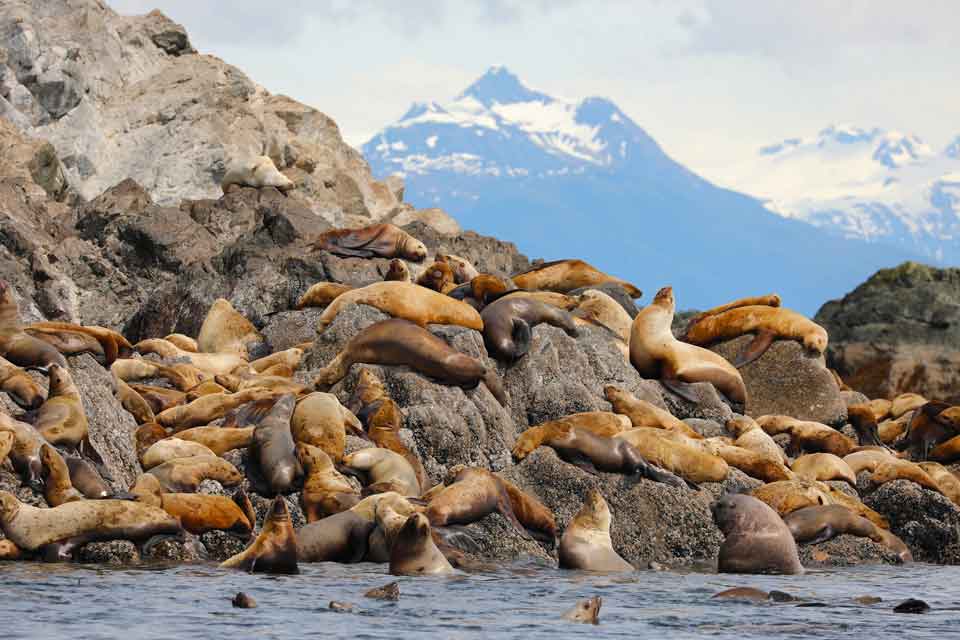Steller sea lions are the largest member of the Otariids—the eared seals—which includes sea lions and fur seals. They are the fourth largest pinniped.
At haulouts and rookeries they are largely social animals. While foraging at sea they may travel in groups of up to 12 animals. They may travel long distances to congregate where food is abundant, but they are not migratory.
Steller sea lions have external ear flaps (pinnae) and are quadrupedal on land, which means they can use all four limbs to walk. They swim using long front flippers for propulsion and hind flippers for steering.
They have coarse hair that is buff to reddish brown in color. They have long whiskers (vibrissae) on their muzzles which they use for sensing prey and traveling under water.
Males are larger than females and can weigh three times as much as adult females.
Steller sea lions are generally recognized as a single species, but there are two distinct populations which are now subspecies:
Eumetopias jubatus jubatus is known as the Western Steller Sea Lion. This Western population includes the Gulf of Alaska, Aleutians Islands, Bering Sea and Asia
Eumetopias jubatus monteriensis is known as Loughlin’s Steller Sea Lion. This Eastern population includes Southeast Alaska, British Columbia, Washington, Oregon and California

Steller sea lions are named for Georg Wilhelm Steller (1709-1746), a German naturalist and explorer who was a member of Bering’s expedition to Alaska in 1741 and first described the species.
Males can weigh up to 2,500 pounds!
Colder temperate to subarctic waters of the North Pacific rim from Japan, Russia, the Aleutian Islands, Bering Sea, Gulf of Alaska, Southeast Alaska, the Canadian Pacific coast, and as far south as the Channel Islands in California.
From the rocky shores of the coast to the outer continental shelf where they feed in benthic and pelagic zones. They may cross oceanic waters in some parts of their range. They need both terrestrial and aquatic habitats. They mate, give birth and rest on land (or ice in the Bering Sea).
Opportunistic feeders of fish (including salmon, herring and flatfish) and cephalopods (squid and octopus). Occasionally birds and seals.
Transient orcas and sharks
Steller sea lions have teeth but do not chew. They use their teeth to thrash their food into smaller pieces. They can consume smaller prey whole while underwater. They can dive up to 1,500 feet and stay underwater for over 13 minutes.
Sea lions do not migrate but do center their foraging activity around a central haulout. Foraging trips may be only dozens of miles from haulouts, though young sea lions can swim 75 miles between haulouts while adult males have been recorded to travel over 500 miles.
Sea lions make low frequency roars or barks, particularly when hauled out at rookeries or haul outs. Females and pups use vocalizations to recognize and bond with each other.
Sea lions are highly colonial, polygynous breeders. Females breed with dominant males that defend territories on breeding beaches or rookeries—only a small proportion of bulls father the majority of pups each season. They use the same rookeries to breed and give birth each year. Rookeries are usually on remote islands safe from most predators.
They breed in late spring and after a 3 month delay of implantation and year of gestation, pups are born the following May through July. Twins are rare. Females stay with their pups continuously for the first 7 to 10 days and then start making foraging trips up to 24 hours. Pups are adapted to fast during the time the females are away. Females use smell and vocalizations to recognize and bond with their pups. Weaning usually occurs within the first year, but pups and juveniles may be dependent on mothers for longer. Pups are the same color as adults by the end of their second year.
Threats to Steller sea lions include predation, climate change, contaminants, disease and parasites, disturbance, entanglement, commercial fishing effects, and reduced prey abundance and quality. They were culled and hunted commercially in the US until 1972 for their meat, hides, oil and other products, but now are only harvested by Alaska Natives for subsistence.
Steller sea lions were listed as threatened under the Endangered Species Act in 1990 due to a dramatic population decline in the western part of their range, in particular the Gulf of Alaska and the Aleutian Islands. In 1997 they were reclassified by NOAA Fisheries as two distinct populations. The Western population (Gulf of Alaska, Aleutians Islands, Bering Sea and Asia) was listed as endangered while the Eastern population (Southeast Alaska, British Columbia, Washington, Oregon and California) was listed as threatened. The Eastern population has since recovered and was delisted in 2013.
Both stocks are protected under the Marine Mammal Protection Act.
In compliance with the Endangered Species Act, critical habitat of Steller sea lions (a 20 nautical mile protected buffer around major haulouts and rookeries) and some offshore foraging areas are protected.